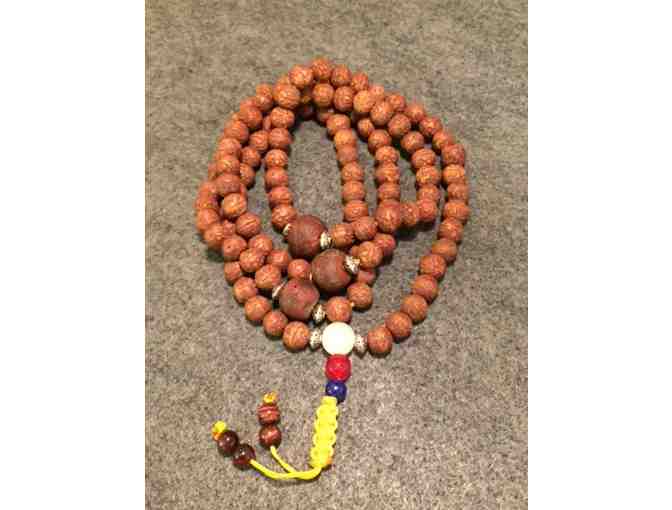Malas (prayer beads)
Phoenix Eye Bodhi Seed Mala with Vintage Spacers, Blessed by Dudjom Yangsi Rinpoche
- Item Number
- 202
- Estimated Value
- 200 USD
- Sold
- 110 USD to bb765f9a0
- Number of Bids
- 4 - Bid History
Item Description
Phoenix Eye Bodhi Seed Mala with Vintage Tibetan Bodhi Seed Spacers, Blessed by Dudjom Yangsi Rinpoche. There are 108 8mm beads plus spacers and guru bead. This mala was personally blessed in Nepal by His Holiness Dudjom Yangsi Rinpoche.
Bodhi Seeds: "‘Phoenix eye’ and ‘Small phoenix eye’ are made from the fruits of Ziziphus abyssinica and Ziziphus jujuba var. spinosa, respectively. The name ‘Phoenix eye’ refers to the eye-like shape that appears on the hard endocarp. Z. abyssinica is native to India and is not cultivated in China. Both were used to make adornments in India [7, 36]. Ziziphus has been mentioned more than one time in the Ramayana and the Mahabharata [37]. The tree and fruit of this genus have great significance in Indian traditional culture." https://ethnobiomed.biomedcentral.com/articles/10.1186/1746-4269-10-15
This mala was made by sangha member, Seth Roberts. Seth says: "Each mala is created with care and love, from the instructions of Padmasambhava, as described in Gyatrul Rinpoche's book, "The Generation Stage in Buddhist Tantra."
"These malas contain 108 counting beads, plus a “marker” bead after each 27th bead, making a total of 111 beads. The marker bead divides the mala into fourths and can be used to remind one to return to mindfulness if 'drifting off 'during practice.
"According to the instructions of Guru Rinpoche, the mala should be stringed with either 3, 5 or 9 threads, to represent the Three Jewels, Five Buddha Families or Nine Yanas (Vehicles). Each mala is made with 3 or 5 individual threads, depending on the thickness of the threads.
"Guru Rinpoche's instructions indicate different kinds of beads create beneficial causes and conditions for various types of practices, including expansive, wrathful and peaceful practices. Some types of beads, especially semi-precious or precious gems, are considered to multiply the number of mantra recitations, sometimes by factors of millions of times.
"The guru beads (the beads where the two sides of the mala come together) are also prescribed by Guru Rinpoche:
“The main guru bead may be composed of three beads, symbolizing the three vajra states of being, the three kayas. The smallest bead on the outside should be blue, perhaps made of lapis. The color blue symbolizes the unchanging mind of ultimate truth. The bead in the middle should be red, to symbolize vajra speech, and the innermost bead should be white, to symbolize the vajra body.”
"In essence, the blue bead symbolizes dharmakaya (Buddha mind), the red bead symbolizes sambhogakaya (Buddha speech), and the white bead symbolizes nirmanakaya (Buddha body).
"After they are tied, the malas are cleansed with smoke from Palo Santo and offered incense and placed on an altar in front of a filled statue of Guru Rinpoche with prayers of supplication and aspiration that they be of benefit.
"May you enjoy your mala and may it bring you much joy and many blessings.
"All malas come with a lifetime guarantee on the stringing, so if it wears out or breaks, as long as I'm alive I'll gladly restring it for you!"
Item Special Note
Shipping cost and CA state sales tax not included.
Donated By:
Seth Roberts
Vajrayana Foundation stores data...
Your support matters, so Vajrayana Foundation would like to use your information to keep in touch about things that may matter to you. If you choose to hear from Vajrayana Foundation, we may contact you in the future about our ongoing efforts.
Your privacy is important to us, so Vajrayana Foundation will keep your personal data secure and Vajrayana Foundation will not use it for marketing communications which you have not agreed to receive. At any time, you may withdraw consent by emailing Privacy@frontstream.com or by contacting our Privacy Officer. Please see our Privacy Policy found here PrivacyPolicy.

